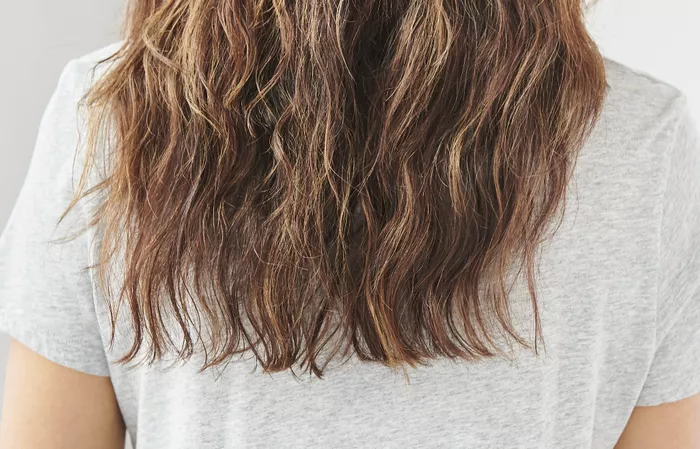Your hair feels rough because its outer layer (the cuticle) is damaged, raised, or missing. This creates a jagged texture that lacks smoothness. Rough hair can result from external damage, internal health issues, or improper care routines. Let’s explore the causes, science, and solutions step-by-step.
Hair Structure 101: Why Smoothness Matters
Hair has three layers: the cuticle, cortex, and medulla.
- Cuticle: The outermost layer, made of overlapping scales (like roof shingles). Healthy cuticles lie flat, reflecting light and feeling smooth.
- Cortex: The middle layer, holding proteins (keratin) and moisture. It gives hair strength and elasticity.
- Medulla: The innermost layer (not always present), with a soft, spongy texture.
When the cuticle is damaged, the cortex loses protection. Moisture escapes, proteins break down, and hair becomes dry, frizzy, and rough.
Common Causes of Rough Hair
External Damage
Heat Styling:
-
- Blow dryers, straighteners, and curling irons strip moisture.
- High heat melts the cuticle, causing cracks. Over time, hair becomes brittle.
Example: Using a flat iron daily at 400°F without heat protectant.
Chemical Treatments:
-
- Dyes, bleaches, perms, and relaxers contain ammonia or sulfates.
- These chemicals lift cuticles to penetrate the cortex, weakening bonds.
Example: Bleaching hair multiple times in a month.
Environmental Stressors:
-
- Sunlight: UV rays break down keratin proteins.
- Pollution: Dust and smoke cling to hair, creating friction.
- Hard Water: Minerals (calcium, magnesium) build up on strands, blocking moisture.
Example: Swimming in chlorinated pools dries out hair.
Mechanical Damage:
-
- Rough brushing, tight hairstyles (ponytails, braids), or rubbing hair with towels.
- Causes cuticles to snag and tear.
Example: Brushing wet hair aggressively with a plastic comb.
Internal Factors
Nutritional Deficiencies:
-
- Hair needs protein (keratin), vitamins (A, C, E, Biotin), and minerals (iron, zinc).
- Poor diets (low protein, extreme calorie restriction) weaken hair structure.
Example: Vegans lacking iron or B12 may experience brittle hair.
Dehydration:
-
- Hair is 25% water. Lack of hydration makes it stiff and rough.
Example: Not drinking enough water or living in dry climates.
Health Conditions:
-
- Thyroid disorders, hormonal imbalances (e.g., menopause), or scalp issues (dandruff, psoriasis).
Example: Hypothyroidism reduces oil production, leading to dryness.
Medications:
-
- Drugs for acne (isotretinoin), cholesterol, or chemotherapy alter hair texture.
Example: Chemotherapy drugs attack rapidly dividing cells, including hair follicles.
Poor Hair Care Habits
Wrong Shampoo:
-
- Sulfates (SLS/SLES) in shampoos strip natural oils.
- Alkaline formulas (pH >7) raise cuticles, causing roughness.
Example: Washing hair daily with a sulfate-heavy shampoo.
Skipping Conditioner:
-
- Conditioners smooth cuticles and seal moisture. Skipping them leaves hair exposed.
Example: Using only shampoo and air-drying without conditioner.
Overwashing:
-
- Washing too often removes sebum (natural oil), drying out strands.
Example: Oily scalp sufferers washing hair twice daily.
Ignoring Hair Type:
-
- Curly or coarse hair needs more moisture. Using products for fine hair worsens dryness.
Example: A curly-haired person using a volumizing shampoo for straight hair.
How to Fix Rough Hair
Repair the Cuticle
- Use pH-Balanced Products: Hair’s natural pH is 4.5–5.5. Acidic products (apple cider vinegar rinses) flatten cuticles.
- Silicone Serums: Temporarily coat hair to mimic smoothness (e.g., dimethicone).
- Protein Treatments: Fill gaps in the cortex with hydrolyzed proteins (keratin, collagen).
Restore Moisture
- Deep Conditioning: Apply masks with shea butter, argan oil, or glycerin weekly.
- Leave-In Conditioners: Provide all-day hydration (look for panthenol or aloe vera).
- Overnight Oils: Coconut or jojoba oil applied before bed penetrates deeply.
Prevent Further Damage
- Heat Protection: Always use a spray or cream with heat-activated polymers before styling.
- Microfiber Towels: Gentle on wet hair compared to cotton towels.
- Wide-Tooth Combs: Detangle starting from ends to roots to avoid breakage.
Adjust Your Routine
- Wash Less Often: Aim for 2–3 times weekly. Use dry shampoo for oily roots.
- Cold Water Rinse: Closes cuticles after washing for instant smoothness.
- Trim Split Ends: Every 6–8 weeks to prevent splits from traveling upward.
Long-Term Solutions for Healthy Hair
Diet Changes
- Eat Protein-Rich Foods: Eggs, fish, lentils, and Greek yogurt support keratin.
- Omega-3 Fatty Acids: Found in salmon, walnuts, and flaxseeds to boost scalp oil.
- Stay Hydrated: Drink 8–10 glasses of water daily.
Medical Checkups
- Test for deficiencies (iron, vitamin D) or hormonal issues.
- Treat scalp conditions with medicated shampoos (ketoconazole for dandruff).
Protective Styling
- Loose Braids: Reduce friction from wind or fabrics.
- Satin Pillowcases: Minimize breakage while sleeping.
Myths About Rough Hair
“Cutting Hair Makes It Grow Faster”: Trimming removes damage but doesn’t affect growth rate.
“Natural Oils Fix Everything”: Oils can’t repair split ends; they only add temporary shine.
“Expensive Products Work Better”: Drugstore brands with ceramides or squalane can be equally effective.
When to See a Professional
- If roughness persists despite home care, consult a dermatologist or trichologist.
- Signs of underlying issues: sudden texture change, hair loss, or scalp redness.
Conclusion
Rough hair stems from cuticle damage, moisture loss, or internal imbalances. By adjusting your routine, using targeted products, and addressing health factors, you can restore softness. Consistency is key—healthy hair requires patience and care!
Related topics:
Men Turn to ‘New Botox’ for Hair Loss Treatment Amid Breakthrough Discovery
What to Drink to Make Your Hair Grow Faster?
8 Best Shampoos for Curly and Rough Hair


